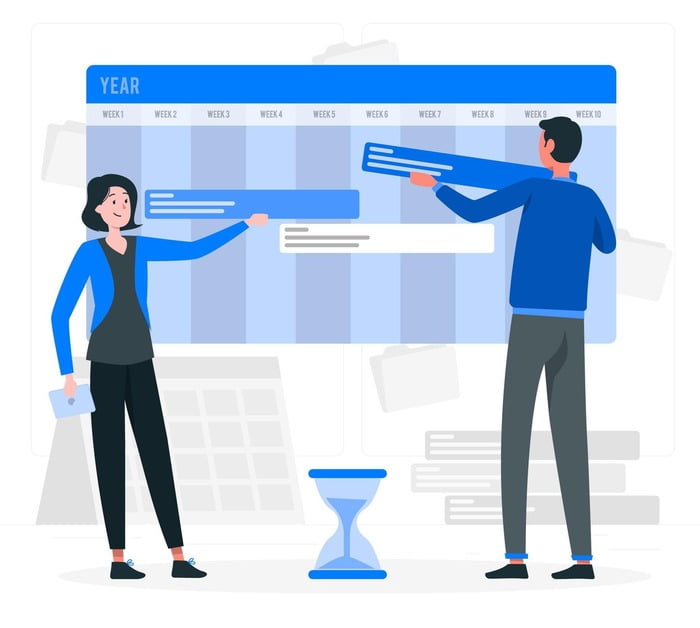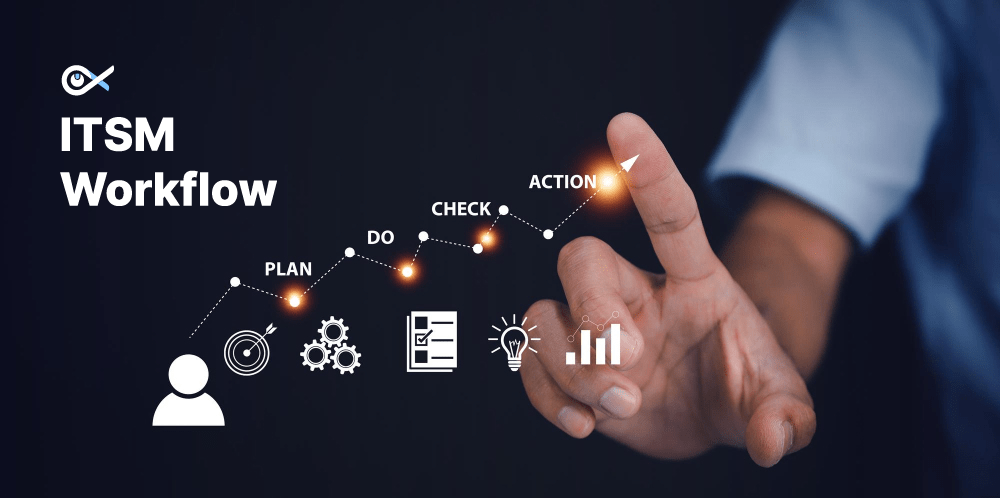Introduction
The imperative for streamlined collaboration and efficient task management stands as an undeniable truth. Amidst the intricate interplay of interconnected processes, systems, and cutting-edge technologies, the significance of adopting a coherent and meticulously structured approach cannot be overstated. This approach is essential not only for ensuring the seamless continuity of operations but also for the timely and adept resolution of the myriad challenges that invariably emerge. Enter Collaborative Work Management (CWM), a transformative force that reshapes the very foundation of how ITOPs teams operate.
In this blog, we will embark on a comprehensive exploration of collaborative work management’s pivotal role within ITOPs teams. We’ll unravel its core essence, delve into the multifaceted benefits it brings to the table, explore cutting-edge solutions that amplify its impact, and find why collaborative work management stands as the pivotal game-changer.
Related blog: ITOM as the Gateway to AIOps and DEX
What is Collaborative Work Management?

Collaborative work management (CWM) is a structured methodology aimed at optimizing tasks, projects, and processes within IT Operations (ITOPs) teams. It involves coordinating, tracking, and streamlining various activities, including helpdesk operations and IT Service Management (ITSM) processes. CWM ensures efficient communication, workflow, and collaboration among team members, fostering a cohesive approach to achieving common goals.
Within ITOPs teams, collaborative work management encompasses a range of activities, from incident handling and service requests to project management and change implementation. It provides a framework that integrates people, processes, and technology to create a unified platform for team members to collaboratively plan, execute, and analyze their work.
In the ITOPs landscape, CWM plays a vital role in enhancing operational efficiency, promoting effective teamwork, and enabling informed decision-making based on real-time insights and historical data. As organizations strive to optimize their IT operations, the adoption of collaborative work management solutions emerges as a strategic imperative to stay competitive and responsive in today’s technology-driven business environment.
The impact of AI and automation on collaborative work management
Collaborative work management has undergone a significant evolution, fueled by the integration of Artificial Intelligence (AI) and automation. These technological advancements have propelled CWM tools to new heights, augmenting the prowess of ITOPs teams.
AI-powered algorithms now possess the ability to analyze historical data with precision, a capability that can foresee potential obstacles on the horizon. This proactive foresight equips ITOPs teams to preemptively tackle emerging challenges before they escalate, ultimately curbing disruptions and ensuring smoother operations. For instance, AI algorithms can predict when server capacities are nearing their limits, prompting ITOPs to allocate additional resources in anticipation of increased demand, thereby averting any potential downtime.

Automation, a companion of AI, alleviates ITOPs professionals from the burden of mundane and repetitive tasks. These tasks, such as routing incident tickets, providing routine status updates, and conducting basic troubleshooting, can now be seamlessly executed by automated systems.
By liberating human resources from routine activities, ITOPs teams can focus their expertise and energy on intricate problem-solving and strategic initiatives.
This shift not only optimizes workforce productivity but also enhances the overall quality of service delivery.
Furthermore, the integration of AI-driven analytics within collaborative work management introduces a deeper layer of data-driven insights. These insights serve as a compass for ITOPs managers, guiding them through the labyrinth of performance metrics and trends. For instance, AI can scrutinize historical data and identify recurrent patterns in incident reports. Armed with this information, ITOPs teams can pinpoint underlying issues and implement preventive measures to circumvent potential problems, thus bolstering overall system stability.
Collaborative work management, turbocharged by AI and automation, emerges as a powerful weapon for ITOPs teams. With predictive capabilities, streamlined operations, and enhanced decision-making, this symbiotic fusion not only elevates the efficiency of ITOPs processes but also cements ITOPs teams as strategic drivers of organizational success in an increasingly complex digital landscape.
Benefits of Collaborative Work Management
The adoption of collaborative work management software in ITOPs teams ushers in advantages such as:
Enhanced communication

In ITOPs, effective communication stands as a bedrock principle. Collaborative work management tools operate as a virtual nexus, seamlessly connecting team members and fostering the fluid exchange of vital information.
For instance, in the face of a critical incident, the helpdesk team can swiftly alert pertinent ITSM specialists through the collaborative platform. This real-time collaboration empowers specialists to jointly diagnose and resolve the issue, minimizing delays and reducing the likelihood of misunderstandings. The result is a shared understanding that expedites issue resolution, ultimately amplifying customer satisfaction.
Optimized task allocation

The prowess of Collaborative Work Management (CWM) solutions shines notably in the domain of task allocation. Imagine a multifaceted project demanding diverse expertise from ITOPs team members. CWM empowers project managers to deftly assign tasks based on individual skills and workloads.
For instance, a seasoned network engineer could focus on configuring intricate network settings while a database specialist tackles intricate data integration. This precision-driven allocation ensures tasks are entrusted to the most adept individuals, mitigating bottlenecks and propelling project completion to new velocities.
Streamlined workflows
Within IT Service Management (ITSM) processes, consistency emerges as a vital thread. Collaborative work management tools unfurl the canvas for standardized workflows, deftly guiding team members along established protocols.
For instance, as a service request emerges, the helpdesk team follows a meticulously crafted workflow encompassing categorization, prioritization, and the seamless relay to a suitable ITSM specialist. Such meticulous orchestration minimizes the scope for errors, guarantees the fulfillment of crucial steps, and weaves a seamless tapestry of service delivery.
Real-time visibility
Empowered by Collaborative Work Management (CWM) solutions, ITOPs managers gain an unparalleled vista into ongoing endeavors. Envision a scenario where a substantial software upgrade is underway.
Through the collaborative work management platform, a vigilant project manager observes the dynamic progress across each developmental phase, preemptively identifying nascent challenges and potential roadblocks. This real-time panoramic view allows for judicious intervention, ensuring projects sail unfalteringly and hindrances are thwarted before they escalate into concerns of consequence.
Data-driven insights
ITOPs generate a wealth of data, a virtual goldmine for informed decision-making. Collaborative work management solutions fortified with data analytics prowess empower ITOPs teams to excavate insights from historical and real-time data.
For instance, meticulous scrutiny of recurrent incidents over a delimited timeframe could unearth underlying systemic issues necessitating sustained remedies. Armed with such sagacious insights, ITOPs teams adeptly enact preventative measures, effectively tempering the frequency of incidents and bolstering the resolute stability of the overarching system.
Increased accountability
Collaborative work management tools assume the mantle of instilling heightened accountability within ITOPs teams. Through vigilant tracking of task progression and completion, these tools interweave a fabric of responsibility, ensuring every team member stands accountable for their designated roles.

In an ITSM milieu, envision the initiation of a change request – here, the appointed change manager shoulders the mantle of overseeing the lifecycle in its entirety, from meticulous planning and requisite approval to precise implementation and discerning evaluation. Such elevated accountability not only enhances individual ownership but also creates a milieu of shared responsibility.
Collaborative work management has a direct positive impact on employee productivity. By simplifying communication, task allocation, and processes, it facilitates more efficient work. The clarity in roles and deadlines reduces confusion, and automation of routine tasks saves time for higher-value work. This heightened productivity not only benefits ITOPs teams by making them more agile and responsive but also contributes to the overall success of the organization as they effectively tackle challenges and seize opportunities.
Employee productivity
Collaborative work management stands as a potent driver of enhanced employee productivity within ITOPs. By streamlining and optimizing essential aspects of work processes, collaborative work management engenders a more conducive environment for efficient task execution. Clear and streamlined communication lies at the core of collaborative work management. It eradicates communication bottlenecks and ensures that relevant information reaches the right individuals in a timely manner.
This real-time exchange of information enhances decision-making and prevents unnecessary delays, thus fostering an atmosphere where tasks are completed with increased swiftness.
Also, collaborative work management minimizes redundancy and empowers employees to focus on areas where their skills are most impactful. The delineation of roles and responsibilities not only avoids duplication of efforts but also cultivates a sense of ownership and accountability, resulting in tasks being accomplished more effectively.
What are Collaborative Work Management Solutions?
Automated ticket allocation
Automated ticket allocation is at the forefront of collaborative work management solutions, powered by the synergy of AI and automation. This ingenious solution optimizes the distribution of tasks by leveraging AI algorithms that analyze the nature of incoming tasks and automatically assign them to the most suitable team member. In the context of IT support, when a user submits a ticket, AI evaluates the issue’s complexity and matches it to the agent with the relevant expertise. This streamlined process not only eliminates manual ticket routing but also ensures that critical issues receive prompt attention from the most qualified personnel.
Furthermore, automation expedites the entire process, enhancing efficiency. As AI-driven algorithms become adept at recognizing patterns, they can predict the optimal task assignees based on historical data, reducing the need for human intervention. This not only accelerates response times but also simplifies the task allocation process, allowing team members to focus on value-added activities. The integration of AI and automation in Automated Ticket Allocation transforms a potentially cumbersome task into a seamlessly orchestrated process, demonstrating how technology simplifies complex workflows.
Personalized daily updates and reminders
The ability to stay organized and well-informed is paramount. Collaborative work management solutions leverage AI-driven algorithms to deliver personalized daily updates and Reminders tailored to each team member’s preferences and responsibilities. Through the amalgamation of AI and analytics, the CWM tool gathers insights from individual task lists, project timelines, and meetings to generate concise summaries that highlight progress, upcoming deadlines, and crucial tasks for the day.

Moreover, AI-enabled reminders ensure that vital tasks are not overlooked. By analyzing historical data and behavioral patterns, the CWM tool can predict the optimal time to send reminders, maximizing their impact. For instance, a project manager overseeing a software development initiative would receive timely reminders for code review deadlines or quality assurance checkpoints.
These notifications, backed by AI’s predictive capabilities, simplify the task of tracking multiple activities and deadlines, empowering team members to manage their workloads effectively.
Customized email responses
In industries centered around customer satisfaction, effective communication is pivotal. Collaborative work management solutions leverage AI-powered customization to enhance engagement through email responses. For instance, when a customer submits a query, the CWM tool uses AI-driven personalization to craft automated yet personalized email responses. These responses acknowledge the inquiry, provide an estimated response time, and even offer relevant resources based on the nature of the request.

AI’s ability to analyze customer preferences and historical interactions ensures that email responses align with individual expectations. Automation further simplifies the process by sending these responses promptly, ensuring customers receive acknowledgment and relevant information without delay.
By infusing AI and automation into customized email responses, Collaborative work management solutions enable organizations to enhance customer satisfaction while simplifying the process of maintaining consistent and personalized communication.
Updated knowledge base
The evolution of collaborative work management solutions has given rise to an advanced Knowledge Base empowered by AI-driven insights. The knowledge base, now a repository of solutions, best practices, and troubleshooting guides, is a testament to how AI simplifies the process of sharing and accessing information. Through the application of analytics, the CWM tool analyzes data patterns to identify recurring issues, frequently asked questions, and trends in user interactions.
This AI-driven knowledge base offers a wealth of information that is easily accessible to both support agents and end-users. Support agents can quickly find step-by-step instructions for resolving common issues, while end-users can utilize self-service options to troubleshoot problems on their own. The AI-powered analytics not only simplify the process of documenting solutions but also provide insights into emerging trends and areas of improvement. This ensures that the knowledge base remains relevant and valuable, enabling continuous learning and enhancing the organization’s ability to address challenges effectively.
Related blog: What is the difference between ITSM and ITOM? And how can you use their collaboration to your advantage?
Wrap Up
Collaborative work management assumes a pivotal role in modern business operations, much like a conductor guiding an orchestra. It orchestrates diverse efforts, yielding harmonious outcomes and empowering ITOPs teams to deftly navigate challenges. The benefits of collaborative work management software extend beyond streamlined task administration, permeating into enriched communication, heightened accountability, and data-driven decision-making. In the complex realm of intricate technological landscapes, the adoption of collaborative work management transcends being a mere option; it emerges as an imperative for those envisioning excellence in the digital epoch.
This transformative expedition into collaborative work management promises to unveil a landscape of amplified efficiency and synergy. By embracing this robust framework, ITOPs teams position themselves at the forefront of operational excellence. As the digital terrain continues to evolve, collaborative work management emerges as a guiding beacon, illuminating the path to success with its orchestration of synchronized efforts and its facilitation of optimal communication.



















